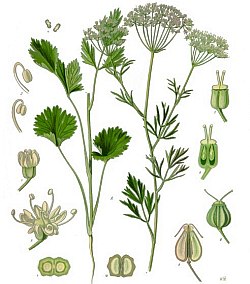General History of Anise.
(Pimpinella Anisum, Linn.)

Many of the well known Greek and Roman authors, including Dioscorides, Theophrastus, Pliny and Paladus spoke of the cultivation and uses of anise.
Charlemagne, in the ninth century, commanded that anise be grown on the imperial farms. Albertus Magnus (1193/1206 – 1280), a priest who was perhaps the most widely read author of his time, speaks highly of anise.
Despite being cultivated for at least 2,000 years, there has been very little development of improved varieties.
Medicinal Uses of Anise Throughout History.
Anise was given the nickname, Solamen intestinorum, the comforter of the bowels.
The Romans often served spiced cakes at the close of ‘rich entertainment’ to avoid indigestion and flatulence. It was quite common for these cakes, known as mustaceoe, to be served at the end of a marriage feast. We found two slightly different recipes for mustaceoe. One included meal, anise, cumin and other aromatics. The other recipe included anise seeds, cumin, fat, grated bay bark, new wine and cheese. The tradition of wedding cake stems from this early use of spiced cake made with aniseed.
Gerard, author of Herball or Historie of Plants(1597), a work that borrows its information liberally from Dr. Priest’s earlier work Pemptades (1583), says of anise: “The Aniseed helpeth the yeoxing, or hicket (hiccough), and should be given to young children to eat which are like to have the falling sickness, or to such as have it by patrimony or succession.”
Germans believed so strongly in the medicinal value of anise that during the 1800s they often flavored their household bread with whole aniseed.
Anise & The Animal World.
Anise oil destroys lice and other biting, itch-inducing insects. It was once mixed with lard or spermaceti (whale oil) and used as an ointment for the treatment of skin irritations.
Anise oil used alone or in combination with cheese has the reputation of being an excellent bait for mousetraps.
In one historical work on beekeeping, it was suggested that anise oil was the quickest way to attract bees when there are no flowers to be found. The author mentioned touching the cork from a bottle of anise oil to his bee boxes to encourage their return from half a mile or more.
In veterinary science, anise is often mentioned for the treatment of a variety of intestinal issues in animals including dogs and horses.
Additional Anise Information.
Our Herb Garden also has guides on Growing Anise and Anise Companion Planting.